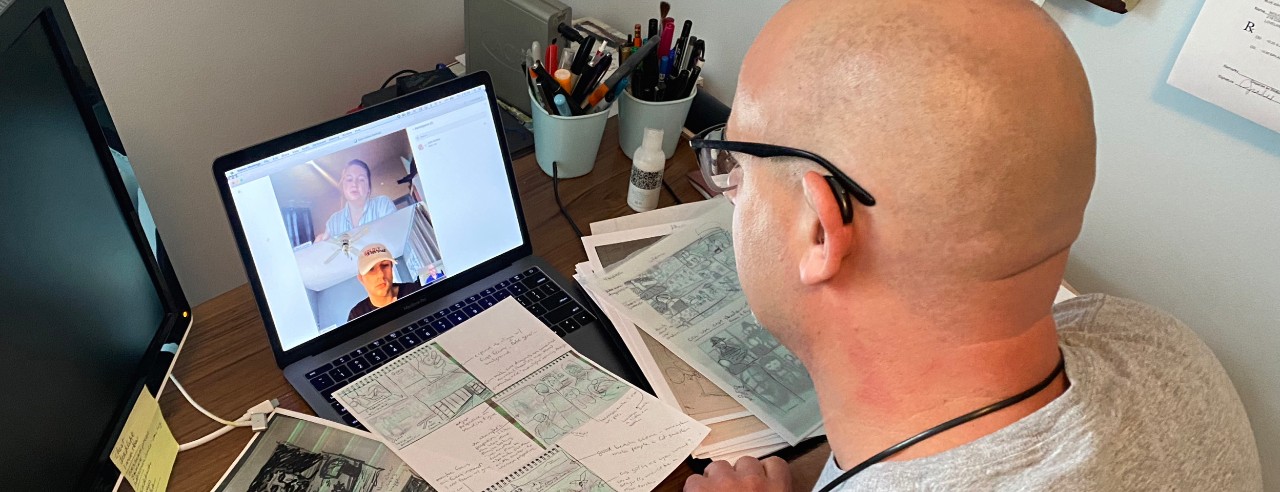
UC faculty and staff complete historic academic undertaking in response to COVID-19
As spring semester wraps up, UC shares details of moving 8,000 courses to remote instruction
As the University of Cincinnati enters finals week during one of the most chaotic and disrupted semesters in its history, UC leaders are acknowledging the historic effort to move the entire academic enterprise to remote learning in response to COVID-19.
The university announced on March 10 that effective March 14 UC would suspend face-to-face instruction.
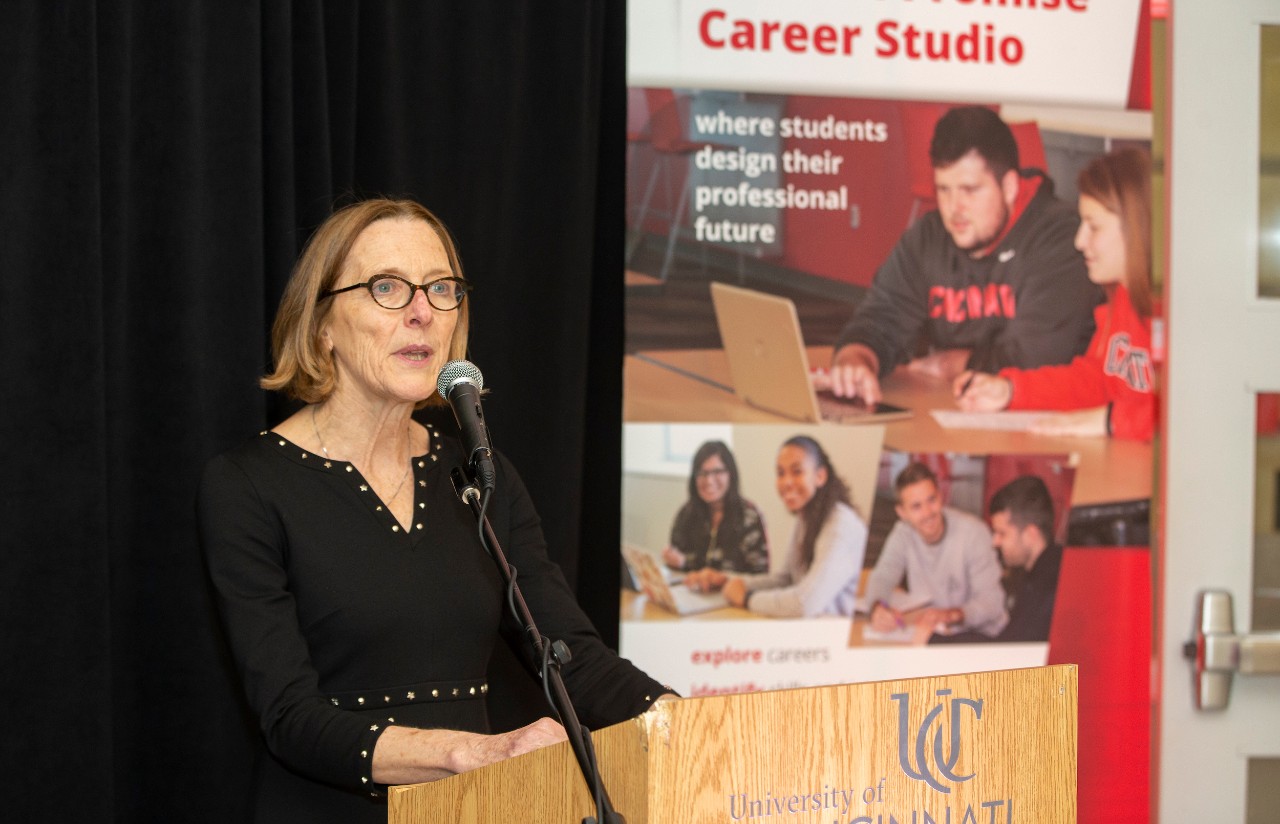
UC Provost Kristi Nelson speaks during the Bearcat Promise studio opening on campus in January.
When students returned from spring break 12 days later, all courses — more than 8,000 of them — had gone online only.
"I am extremely proud of how the UC community has transitioned to remote teaching and learning," says Kristi Nelson, executive vice president for academic affairs and provost. “Our faculty have been creative and flexible and kept teaching excellence and student success at the forefront of their efforts.
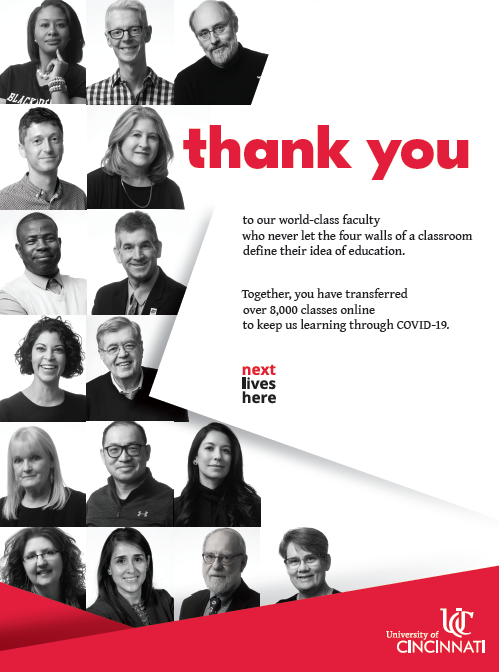
A full page ad in the Cincinnati Business Courier on April 24 thanked UC faculty for their efforts to keep the university learning during COVID-19. The faces are this year's Faculty Award winners, who were also recognized last week.
"The magnitude of work, planning and care that has gone into this effort is quite incredible. From our IT team cleaning and repurposing computers for students and faculty in need, to our career education, student affairs and advising teams working to provide alternative remote learning experiences and supportive academic and student social services. This has been a tremendous effort and our faculty and staff have gone above and beyond to ensure the UC experience is preserved for our students no matter where they reside."
For many faculty, the challenge of translating their courses to remote-only instruction inspired both care and creativity as they exhibited an even stronger commitment to student success and academic excellence, both of which are at the bedrock of UC's Next Lives Here strategic direction.
Though only a small sample, below are examples of UC’s response as it relates to how faculty stepped up to teach — and reach — their students despite difficult circumstances this semester.
Physics fundamentals from a distance
UC physics professor Alexandre Sousa said he was impressed with the way technology has risen to the occasion during the COVID-19 crisis.
Sousa has been teaching physics to first-year students in UC’s College of Arts and Sciences via video teleconference, writing out equations and solving problems with a stylus pen on his iPad for everyone to see at home.
And he and his teaching assistants have been conducting breakout sessions with small groups to walk them through particularly challenging problems.
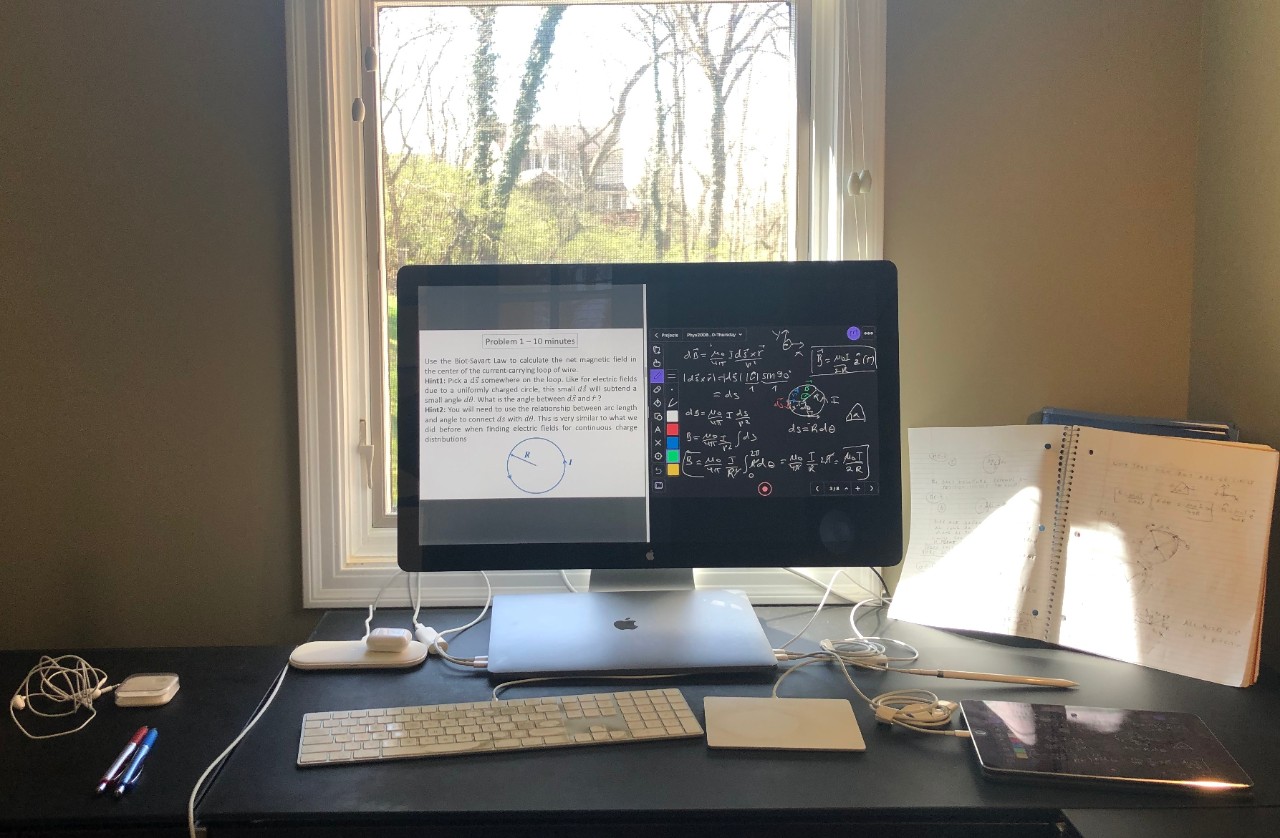
UC physics professor Alexandre Sousa's new classroom. He now writes out equations and solves problems with a stylus pen on his iPad for everyone to see at home.
“We normally would walk around the classroom and ask students in a Socratic way how they’re approaching a problem. And we’d have a student explain the solution to classmates who are having difficulty,” Sousa said.
Videos have replaced in-class demonstrations, but students regularly interject questions during the interactive sessions.
“If this outbreak happened 10 years ago, this kind of teaching would be virtually impossible to do. But the internet speeds, bandwidth and the quality of video conferencing has greatly improved,” he said.
One of his graduate students, David Dueñas Tonguino, presented a research paper remotely this month to the American Physical Society after its conferences were canceled due to the coronavirus.
Sousa said he thinks physics students will be just as prepared for their next educational step at UC as the students he taught during the last semester.
Hands-free biology
Biological sciences is one of the most popular programs in UC’s College of Arts and Sciences. But how do you teach lab skills to more than 700 students who can’t come to a lab?
That was the challenge for assistant professor Brent Stoffer who supervises introductory biology labs.
“Students are accustomed to spending three hours each week in the lab doing hands-on activities — designing their own experiments and learning transferable skills along the way,” he said.
“The big challenge was not just the physical space but the sheer scale at which we operate,” he said. “We had to transition 720 students to a digital space.”
Stoffer said he has been keeping up with the latest digital tools, particularly videos demonstrating lab concepts and measuring the students’ comprehension.
Students also used digital tools to put together research presentations as they would under normal circumstances.
“It was rewarding to see students step up and go above and beyond our expectations,” Stoffer said.
Projecting a beautiful day in the neighborhood
Richard Tillman, an assistant professor of psychology in UC’s College of Arts and Sciences, wanted to do something relatable for the 225 students in his three classes who were coming back from spring break and into the strange new world of social distancing and online learning. Cleverly, Tillman decided to take the soft-spoken, reassuring Mr. Rogers approach and made a “We are Back” video from home, while lying on the couch with a warm fuzzy blanket, eating a bag of chips and watching Netflix. The short film ends with Tillman pulling off the blanket to reveal himself in professional attire, letting the students know: “We can do this!”
“The video has been the biggest hit. I've never done one at home, so I was worried about the reception, but it’s been amazing,” Tillman says of feedback on the video and the other “extras” he’s been doing to let students know that he understands what they are going through.
To further help students, Tillman has vastly increased communications with students via online class and individual conversations and discussion boards where students can connect with each other. “Students have had all their in-person classes go online, and they're generally anxious about their future, as well as having many health care workers in my classes, who are very stressed.”
He said he sees the results of his efforts as significant: Grades are up, morale is good and student feedback is at an all-time high — and even emotional at times.
“I usually get a few very appreciative emails each semester. But this semester, it's many, and they make me tear up that what I'm doing is making a difference. That even under pressure and stress, they're taking my lead and lifting others up as well. It's beautiful.”
This has been a stressful and anxiety inducing time for all of us, says Abby McCarthy, a sophomore psychology major. “Having a professor on the same page has really helped to alleviate some of that anxiety for me. I’m really looking forward to getting back into our class material."
Mindfulness training
Before COVID-19, Tia Sherèe Gaynor, assistant professor of political science, and Brian Metcalf, assistant professor of psychology, were among 16 faculty members who took part in the Mindfulness and Teaching Faculty Learning Community through UC’s Center for the Enhancement of Teaching and Learning (CET&L). The Learning Community focuses on strategies to build resilience, focus and cultivate wellness in the classroom — strategies which have come in handy during the shutdown.
For example, Gaynor says, given all the feelings (“even the negative feelings”) one can experience during a crisis, she asked her students to set a foundation for each day using a mindfulness tool called a “gratitude practice” by writing three things that would “make today a great day.” Mindfulness practices such as this, she says, are a holistic, thoughtful way to deal with feelings and create a learning environment that allows students to be emotional humans while also showing themselves a bit of grace.
And the training is beneficial to the instructor as well, says Metcalf. “While I like to think that I have done a good job with that all along, this has made me try more mindfully to reach out to them regularly. To let them know I am here, I care, I am going through this, too, and am unsure about a lot of things. That I will work to help them reach the finish line. And that I am proud of everything they are doing and how they are adjusting.”
Teaching virtually while living the reality
If ever there was an opportunity for students to study the interface of mankind and nature, COVID-19 fits the bill, say faculty members Lucinda Lawson and Jack Mewhirter who co-teach an introductory environmental studies course in UC’s College of Arts and Sciences.
“Aspects of environmental health, vaccines and human-wildlife interactions were something that we talked about before any of this happened, so we are using the topic to loop back into the course,” says Lawson, an assistant professor of research in biological sciences.
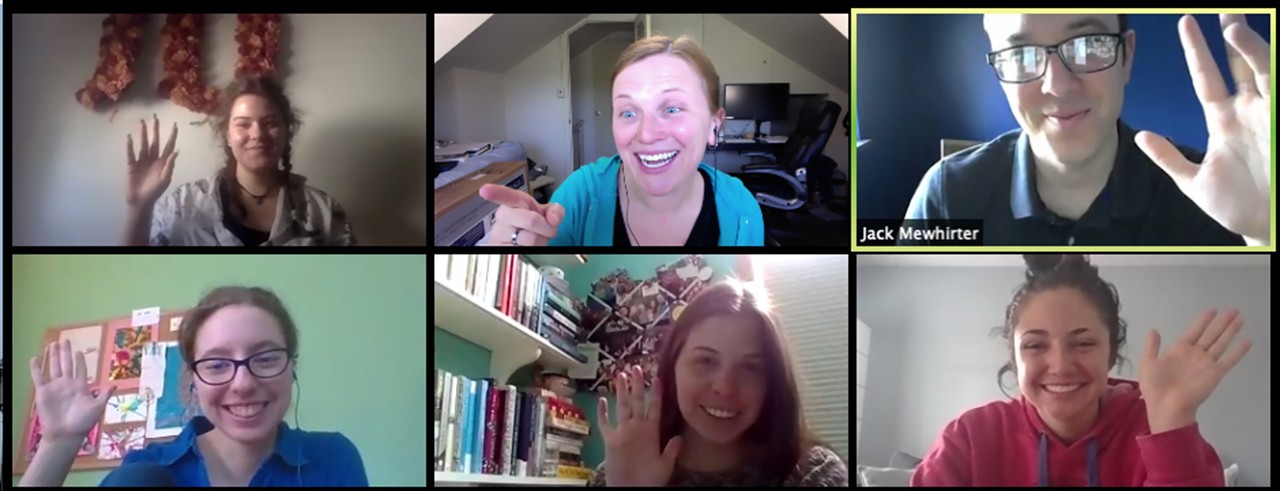
Members of a UC introductory environmental studies course meet online.
Because this is only the third time that the team has taught this course, which typically employs a very interactive in-person format, both Lawson and Mewhirter spent spring break working on strategies that would allow for their 70 students to complete the semester in innovative ways to keep as much of the problem-based group learning style in place that make this course so impactful. Learning from other successful online transitions at UC, classwork was adjusted to allow students larger windows of time to work together and respond with assignments.
Virtual “class” times are moved to Zoom at the regular class period, but are optional and serve as an opportunity to check in, share environmental news articles and connect with peers. Lectures are recorded so students can jump online when it fits with their new routines.
The deconstructed schedule was born out of student concerns over the lack of internet access or reliable access, says Mewhirter, an assistant professor of political science. “That surprised me,” but led to opportunities for greater communications in the form of four to five announcements a week and the use of discussion boards.
Ready to Roomba in record time
“Sensing in Animals and Robots” is a biology course where students learn the fundamentals of how behavior is guided by senses, in both animals and robots. The second half of the teaching effort this semester was dedicated to having the 12 students enrolled in the course experiment with robots (i.e., repurposed Roomba robots) to learn how to program them to approach light, heat and sound stimuli, while avoiding obstacles.
It’s normally a hands-on course that required a newly designed hands-off approach when the university suspended in-person teaching, says assistant professor Dieter Vanderelst, a research biologist who has a joint appointment in UC’s College of Arts and Sciences and the College of Engineering and Applied Science.
Combined brainpower, however, rapidly tackled the unexpected conundrum; professor Vanderelst co-teaches the course with biological scientists Stephanie Rollmann, professor, and John Layne, associate professor, in the College of Arts and Sciences.
“We weighed different options. Eventually, we agreed on trying to set up a system to maintain students' opportunity for real-time experimentation,” Vanderelst says, by setting up a system whereby the two to three students in each group use software that controls a laptop in the lab collaboratively.
The computer runs the code, controlling the robot over a local wifi network. Students get feedback about the behavior of the robot through a webcam. Only the three instructors are present in the robotics room, observing social distancing and wearing personal protective equipment; being physically present allows the instructors to modify the sensors or move the robots as required (and catch them when they run off).
“We also support the students while they are writing their code. We can see and edit the code of the students,” says Vanderelst.
The team put this system together in a timely response to the current situation, he says, just using the equipment they had available. However, they now look upon the unplanned adaptation as demonstrating that remote teaching of "hands-on" robotics might be possible.
Nothing new about virtual interaction
The Carl H. Lindner College of Business has risen to the challenges presented by the COVID-19 pandemic. After all, business is about relationships and communication, and businesses have been using technology to facilitate virtual interactions for years. Instead of a challenge, Lindner’s leadership views this experience as a teachable moment for the college’s students.
Our pivot has showcased collaborative problem-solving. It has been remarkably smooth and insightful — thanks to faculty, staff and students working together. And such agile learning mirrors critical business needs.
Marianne Lewis, dean of the Lindner College of Business.
“Our pivot has showcased collaborative problem-solving,” said Marianne Lewis, dean of the Lindner College of Business. “It has been remarkably smooth and insightful — thanks to faculty, staff and students working together. And such agile learning mirrors critical business needs. The experience will better prepare our students for their careers and our college for changes in business education.”
Like most colleges, Lindner’s courses have moved to online meeting platforms such as Webex and Microsoft Teams, the latter of which is being used by Lindner instructors to give students a way to work in smaller groups during breakout activities.
The show must go on
Despite being physically separated, UC College-Conservatory of Music faculty, staff and students are working hard to stay connected. Kevin Michael Holzman, interim head of Ensembles and Conducting and director of Wind Studies, recently hosted CCM's Graduate Conducting Seminar online. In addition to holding online classes, Holzman invited three incoming students to connect with current students in a virtual hangout. "We may be far apart, but we're still having fun," he says.
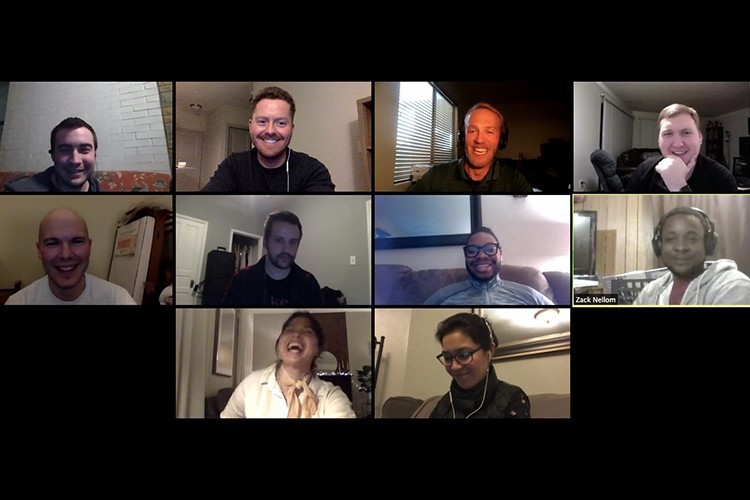
CCM students meet virtually.
Holzman also worked with CCM Professor of Horn Denise Tryon and Liz Freimuth, principal French horn at the Cincinnati Symphony Orchestra, to adjudicate CCM's virtual Andrew Howell Horn Scholarship Competition. The college also restructured its annual Opera Scholarship Competition so it was held virtually and moved both the Musical Theatre Senior Showcase and the Acting Senior Showcase online.
Additionally, patrons who miss seeing the student stars perform in person can tune in to performance videos shared in the college's new CCMONSTAGE Online. The weekly e-newsletter shares videos, stories and other resources designed to help us stay connected even when we have to temporarily stay apart.
“I miss seeing and hearing my students in person and can’t wait for that time,” says CCM cello professor Alan Rafferty. “I also miss the community of our studio class and spending time together. It’s a surreal time, and I’m looking forward to us coming out of this well as a society.” Read more.
A-DAAP-ting to digital
Virtual learning calls for ample creativity and adaptability. Thankfully, the students, faculty and staff of UC’s College of Design, Architecture, Art, and Planning have that in spades.
Peter Chamberlain, industrial design academic coordinator in DAAP’s Myron E. Ullman Jr. School of Design, teaches a hands-on industrial design studio for first-year students. His students had been assigned their final project in the course — creating a chess piece — when UC transitioned to remote learning.
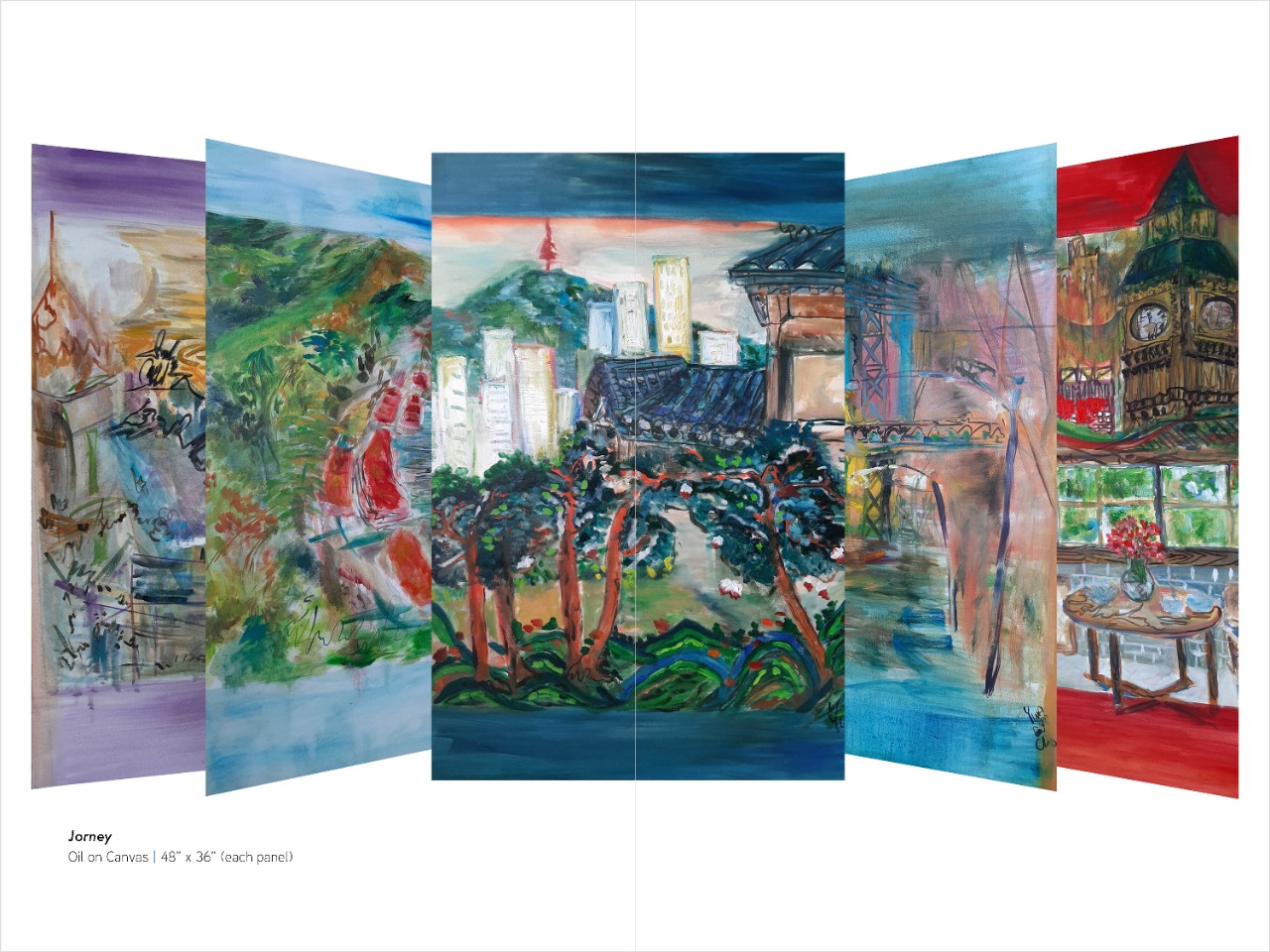
Artwork by senior fine arts student Yunseon Cho as part of her capstone project which will be presented digitally for DAAPworks.
“The students have proven their amazing resilience through their ability to create with what they have available to them in their apartments and parent’s homes,” Chamberlain says.
DAAP Associate Dean of Research Claudia Rebola explains that designers always need to embrace constraints for higher creative outcomes.
“I always tell my students that when design gives us a ‘curveball,’ instead of feeling discouraged, we should feel thankful,” Rebola says. “We celebrate the opportunity to question our design and making in order to have a critical perspective in our thinking to bring about new and more meaningful solutions. Constraints and unexpected situations in the design process have always yielded better results.”
The college’s annual year-end DAAPworks event, showcasing capstone projects from seniors in each school, will be online for the first time, giving students a global audience. DAAPworks.com launches at 6 p.m. Thursday, April 30.
A virtual approach to clinical training
Nursing education hinges on in-person experiences with real patients in clinical environments, so the disruption in traditional learning models required the College of Nursing to rethink the way it prepares students to become intricate members of a health care team.
“It required us to think differently about how to deliver clinical learning, which is hands-on in the hospital and community settings,” says Donna Green, assistant professor and director of the undergraduate nursing program. “It shifted our focus to the clinical reasoning activities we can provide our students that will continue to facilitate their growth as a nursing student and provide them with the skills needed for safe patient care.”
College of Nursing leaders were confronted with the daunting task of transitioning more than 600 undergraduate and accelerated master’s in nursing students across nine clinical courses to a virtual clinical format during the university’s extended spring break. Faculty and staff spent a week and a half meeting 14 to 16 hours a day, weekends included, to review and select virtual clinical software solutions and form an implementation and training plan for more than 80 adjunct clinical faculty and their students.
The impact of COVID-19 is so central to care provided now that continued discussion and evaluation of the pandemic is now a consistent talking point in clinical learning.
Donna Green, assistant professor and director of the undergraduate nursing program
Along with Green, the team included Angela Clark, executive director of undergraduate and pre-licensure programs; Rebecca Lee, director of the RN to Bachelor of Science in Nursing program; Matt Rota, assistant dean of technology; Deborah Schwytzer, director of the undergraduate co-op program; Robyn Wagner, director of skills and simulations labs; and Eileen Werdman, director of the Accelerated Direct-Entry Master of Science in Nursing program.
In the in-person clinical model, groups of five to eight students are supervised by clinical faculty in their delivery of patient care. Now, in the virtual environment, students go through a pre-briefing session with faculty, begin a simulation individually and then complete their virtual simulations with their clinical faculty member in a group setting. The student group discusses the simulation using the “think-aloud” structure for critical-thinking development, in the same way they did during in-person clinical experiences.
Faculty and students also consider the impact of COVID-19 when making patient care decisions, especially in the undergraduate Community as Partner course and accelerated master’s Population, Public and Community Health course.
“The impact of COVID-19 is so central to care provided now that continued discussion and evaluation of the pandemic is now a consistent talking point in clinical learning," says Green.
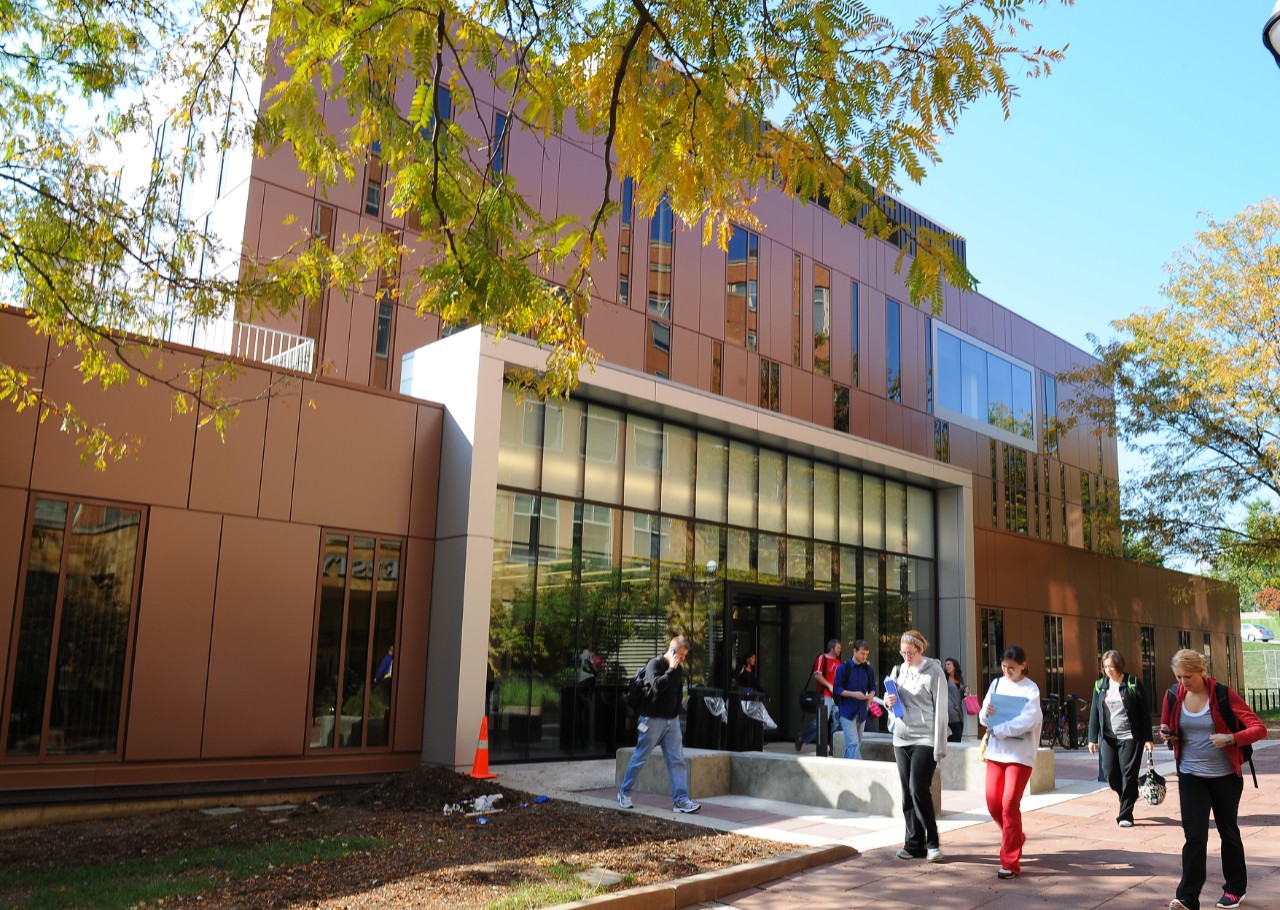
Outside Procter Hall at the University of Cincinnati prior to COVID-19 and the need to social distance.
At a time when colleges across the country have canceled clinical courses altogether, the virtual learning format has allowed UC College of Nursing students to meet their clinical course requirements and remain on track to graduate.
“I feel strongly that our clinical faculty are guiding students in the development of their critical-thinking skills through their immersion of the virtual simulation. The students will be ready and capable of applying their learning when they return to the patient care environment,” Green says.
“We have the opportunity to strengthen the skills needed for new graduates to take their place in the profession,” adds Werdman.
Looking ahead to the summer semester, Werdman is working with Wagner to develop a method for the next cohort of accelerated master’s students to begin their Health Assessment Lab and Fundamental Skills Lab remotely.
During this time, the support of leadership and experience of the college’s faculty and staff has made the transition possible.
“At the College of Nursing, we are fortunate to have an environment that focuses on the integration of technology,” says Rota. “Because of that, we were able to pivot quickly in an effort to provide the most innovative approach and support to faculty and students.”
A ‘watch, practice, do’ discipline
Erin Rumpke, assistant professor in the Department of Clinical and Health Information Sciences, says that having a well-established Medical Laboratory Sciences (MLS) program with both online and campus-based learning tracks means that they have a number of faculty well-versed in the method and practice of teaching online. She says that because of the large number of online courses taught in UC’s College of Allied Health Sciences, the instructional design team is adept at supporting faculty through transitioning courses from the lab to online.
“For our on-campus courses with a laboratory component that required a transition to online formats, our faculty have been able to leverage preexisting online resources creatively to provide content for our students,” says Rumpke. “We have also been able to use audio and video to create our own virtual laboratory activities.”
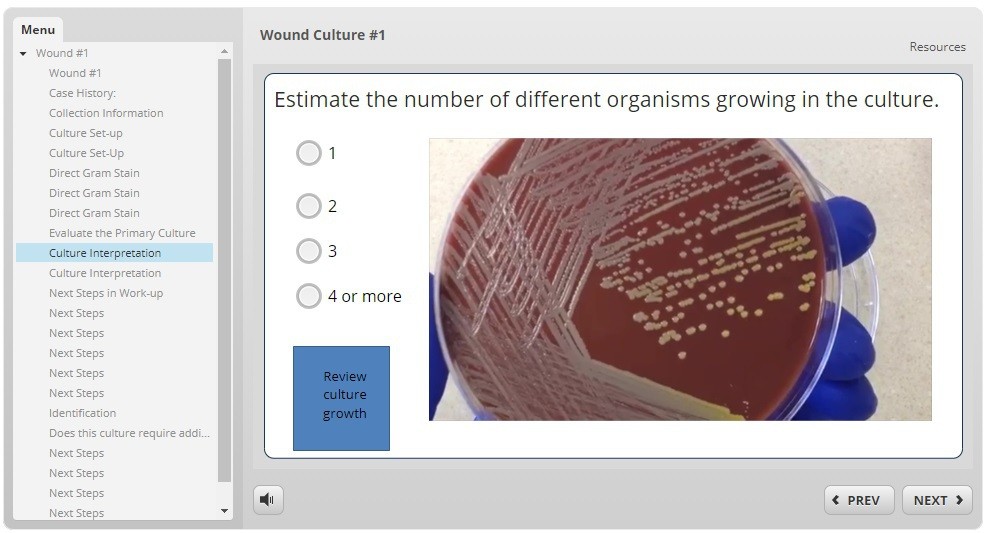
Erin Rumpke combined video and still images to create branching case scenarios, providing students the opportunity to practice critical thinking skills necessary to perform bacterial identification, mimicking traditional culture reading exercises performed in the clinical lab.
Rumpke says the MLS program transitioned five courses that were traditionally lab-based to online formats, with between 20 to 25 students in each. They are also transitioning a summer course as well.
“Clinical education is very much a ‘watch, practice, do’ discipline — so we knew that having content that aligned with hands-on practice and decision making would be imperative,” Rumpke says.
To introduce students to practices of reading bacterial cultures, Rumpke was able to build almost 20 virtual training exercises using software provided by the university, a skill she says she learned by taking the Online and Blended Assessment course taught last summer by Julie Breen who is the director of learning design in the College of Education, Criminal Justice, Human Services, and Information Technology.
“Connecting with faculty from other universities to share information and resources through our professional organizations and social media has also been a tremendous part of our support network,” says Rumpke. “I’ve been reminded during this situation that we are incredibly fortunate to have such a collaborative group of educators across the nation.”
One of the videos Rumpke uses in her virtual lab exercises was shared with her by a faculty member at Wenatchee Valley College in central Washington state. She got written permission from him to modify the videos and to share the resources with other educators as well, a gift that she says pays forward. They are also discussing future collaborations.
“Educators in our discipline have really come together through this challenge, with many instructors sharing resources,” Rumpke says. “I feel more connected to the community of educators in my discipline now more than ever.”
A prescription for change
The James L. Winkle College of Pharmacy has been offering online certificates and graduate degrees since 2006, which include cosmetic sciences, drug development and pharmacy leadership. Due to this previous online experience, the college was able to adapt very quickly to remote learning and assessment for the Doctor of Pharmacy (PharmD) students, says Bradley Hein, associate professor and associate dean for professional education and assessment at the college.
“Due to a flexible faculty and student body that have been supported by a diligent and innovative instructional design and information technology team, we’ve been able to maintain the quality of our program as it has shifted remotely” he says.
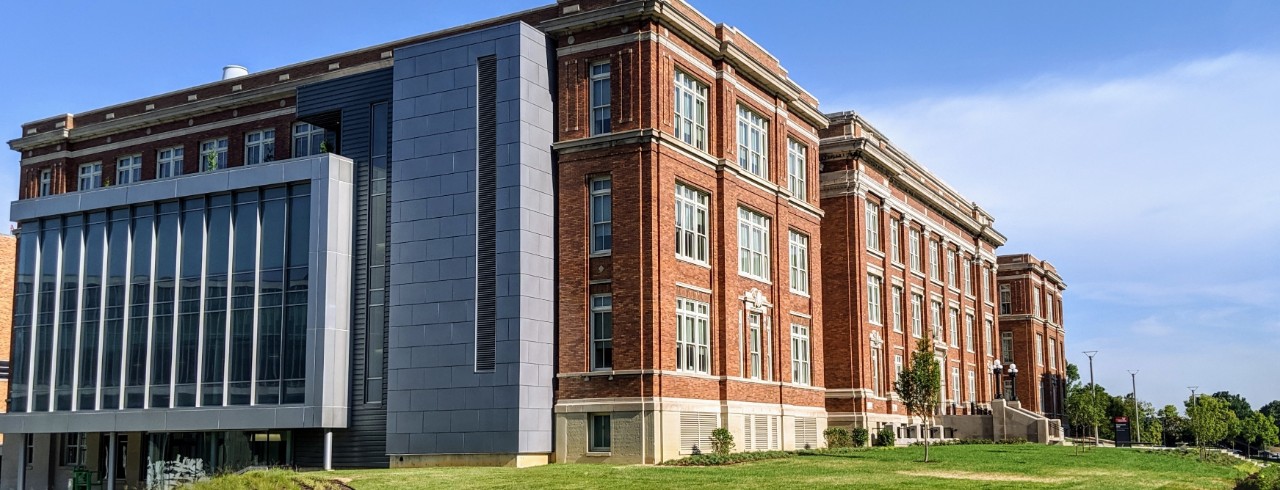
The James L. Winkle College of Pharmacy
The most challenging part of the transition, affecting 250 students, proved to be the small group work in therapeutics and case studies courses, where students learn how to utilize medications to take care of patients. “We weren’t sure we were going to be able to provide this team-based learning environment, but using the expertise of our IT folks combined with Microsoft Teams, we were able to pull it off.” Student feedback indicated that the process was very close to the way it was before the work went remote.
The college faculty, he said, tested several different platforms before settling on Webex and Microsoft Teams for instruction. The college has utilized two assessment processes: ExamSoft and Canvas/Honorlock. ExamSoft is an online assessment platform that has been the main assessment tool for the college for many years. When increased exam security is desired, they use Canvas and Honorlock.
“The instructional design and IT team here has built an impressive array of resources for faculty and students that are posted to SharePoint and can be utilized across the university,” says Hein.
Virtual exposition for engineers
Chemical engineering students in UC professor Stephen Thiel’s class presented their senior design projects in April at a virtual exposition.
The UC College of Engineering and Applied Science students submitted work on a range of design topics, including carbon capture in coal-fired power plants, desalination for use in nuclear plants and converting toxic algae blooms into fuel through fermentation.
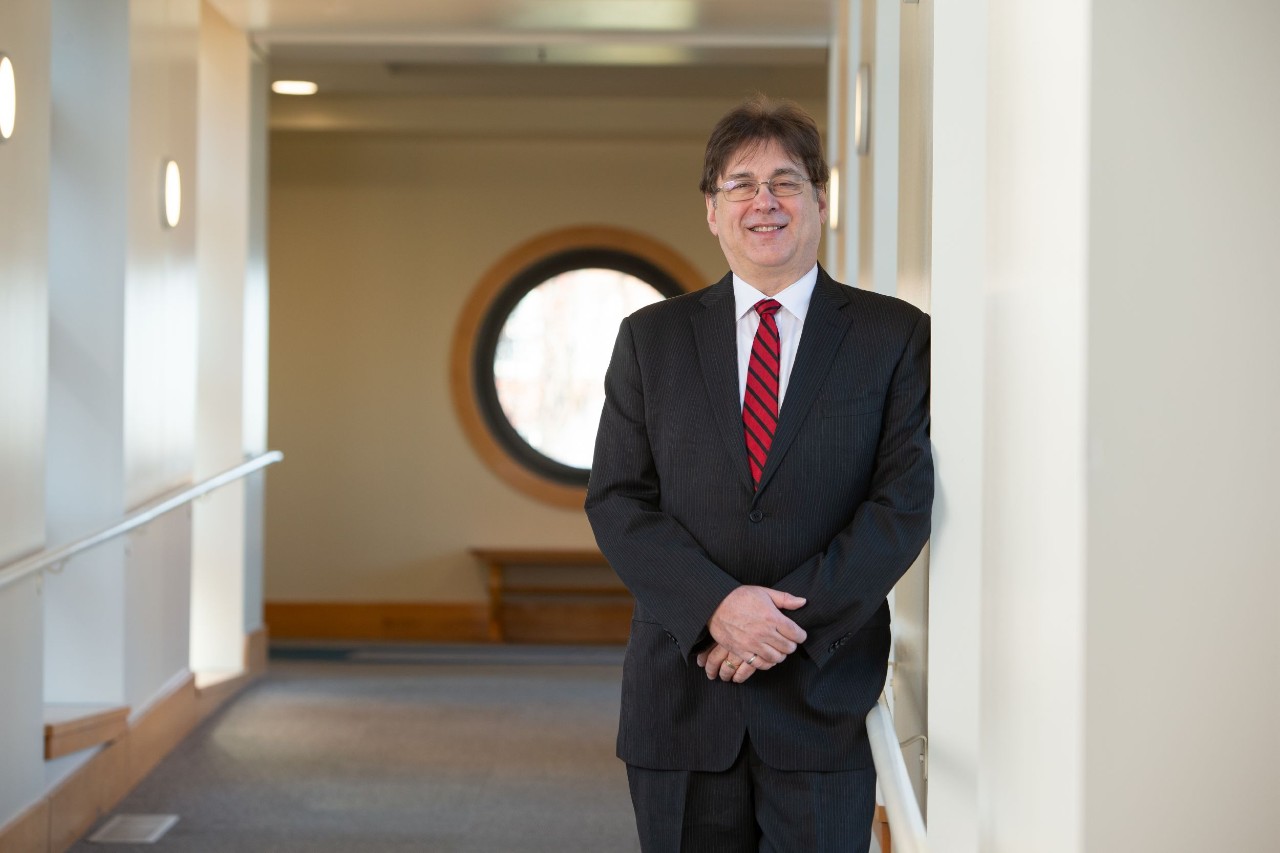
UC professor Stephen Thiel
Thiel said being available to students during the COVID-19 crisis is crucial since, at least for now, they can’t meet face to face.
“The thing that has been most important for me is just making sure I do something to keep communication open,” he said.
Thiel said he has worked closely with the education division of the American Institute of Chemical Engineers, an industry trade group, to network with other engineering professors about what virtual resources work best to prepare students for their future careers.
For their part, engineering students have adapted quickly to their new circumstances and are showing resilience under the duress of the moment, he said.
“I was impressed with the way students are responding. They’ve kept a positive attitude all the way through,” Thiel said.Replace with your text
Aerospace presentations
Despite the coronavirus restrictions, third-year engineering students gave virtual presentations in April to the U.S. Navy on topics such as landing a drone aboard a ship and docking with the International Space Station.
About 60 students presented work from their UC modeling and simulation class to the Naval Surface Warfare Center’s judges in its Crane Division. The Crane Division is one of Indiana’s largest high-tech employers — home to 2,000 scientists, engineers and technicians.
Some of these students in UC’s Department of Aerospace Engineering and Engineering Mechanics may go on to work in naval careers, said assistant professor Rajnikant Sharma.
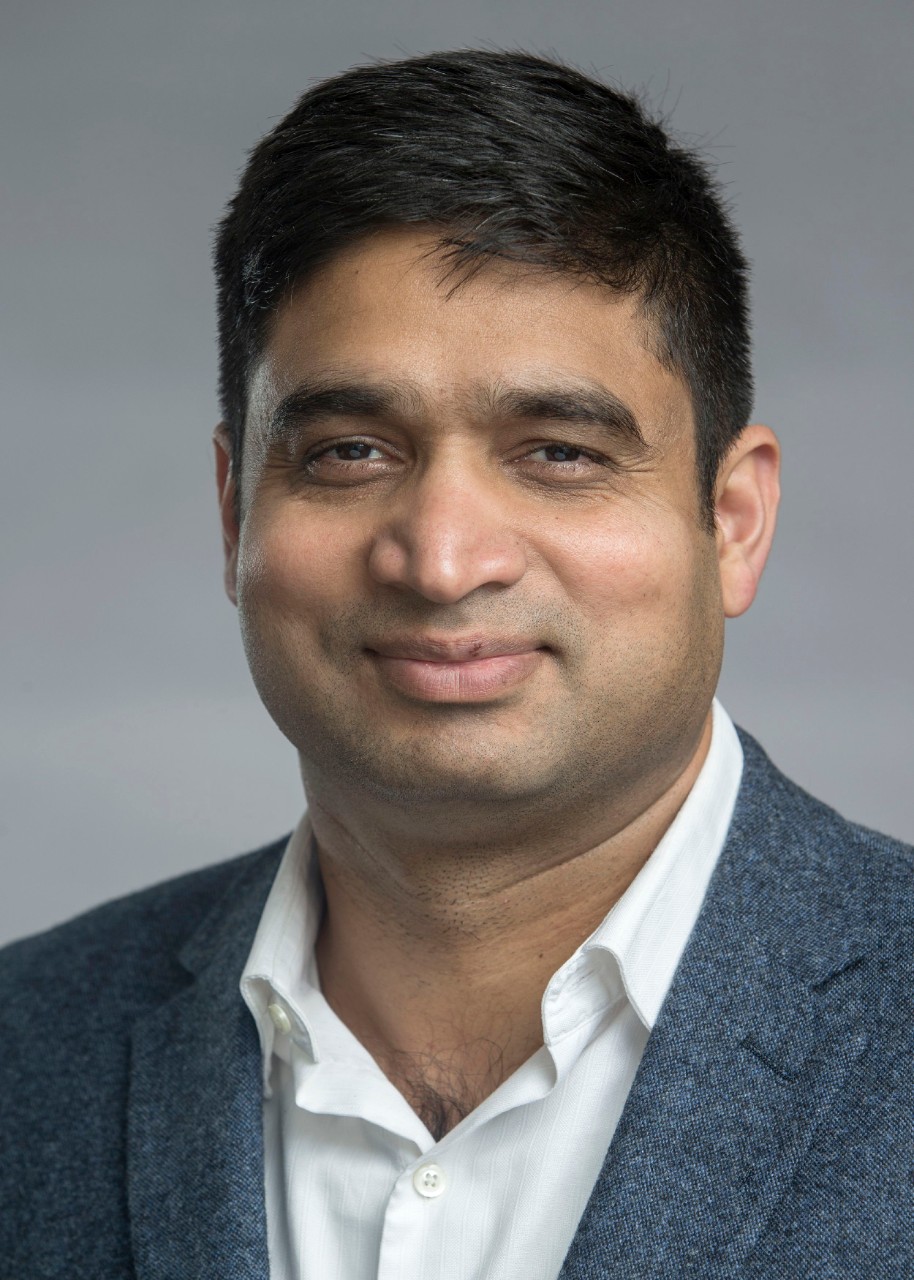
Assistant professor Rajnikant Sharma
“We are developing a naval workforce in data science and computational science,” Sharma said.
Ironically, the virtual presentations gave the Navy more exposure to some of UC’s brightest. Instead of a single Crane representative coming to UC, the students presented remotely to a panel of judges at Crane, Sharma said.
With interactive video conference classes, students are able to absorb the same material as previous classes. But Sharma said he’s looking forward to returning to the classroom.
“We’re realizing the things we took for granted,” Sharma said. “We know how important one-on-one teaching is.”
UC aerospace engineering students Michael Rechtin and Brett Lauerhass are among the third-year students who gave presentations.
Rechtin’s team, which includes students Vince Feldman, Nathan Riddle and Sam Klare, created statistical models examining the COVID-19 pandemic in the Tristate with and without social-distancing measures. He was among the many students at UC who moved from the classroom to remote instruction.
“I think it’s gone pretty well. UC has a lot of tools in place like Canvas and Webex to make it easy. The online instruction has been pretty good in my opinion,” he said.
Giving formal presentations is helpful to preparing him for his career, he said.
“On a co-op, you have an exit presentation. And there were times when I was working on a project (at GE Aviation) where I had to give biweekly updates to senior leadership during a staff meeting,” Rechtin said.
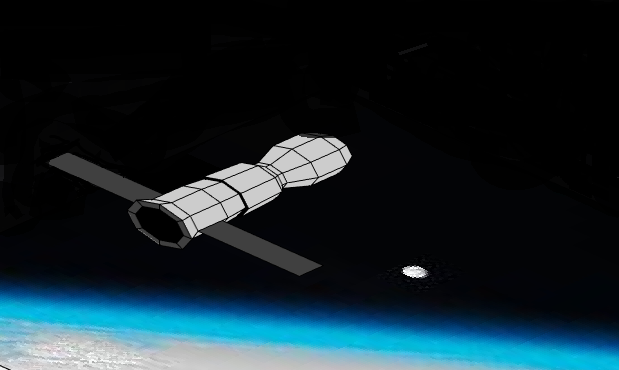
UC students replicated an automated docking procedure for the International Space Station.
Lauerhass’ team, which includes students Ethan Robinson, Peter Glaubitz and Connor Chandler, replicated an automated docking procedure for the International Space Station. Docking two objects that are moving independently on three axes in space is tricky, he said.
“These presentations are a huge part of the aerospace industry. Getting practice like this is good,” he said.
Lauerhass also plays trumpet in the UC Bearcat Spirit Band. The band had to call off its trip to Texas to play for the men’s basketball team when the conference tournament was canceled in March. But his friends are staying in touch during the quarantine.
“It’s been an interesting experience for sure. I’ve gotten to know my housemates much better,” he said. “It’s not ideal. But a silver lining has been the spirit of creativity in staying connected with each other.”
Remote learning in the midst of COVID-19
For medical students at UC, a cadaver is the first real patient most will see during their medical training. The interactions are part of a gross anatomy class which is key to understanding disease process and the body’s response, along with how to care for future patients.
But in the midst of COVID-19, the course, like many in the UC College of Medicine, has been redesigned for remote learning. Previously the medical students learned most of the body’s anatomy during dissection labs and in-peer teaching sessions.
Now they still learn anatomy but rely on a 60-minute video of atlas images of anatomy that students would have encountered during dissection prepared by Bruce Giffin, associate dean for medical education at the College of Medicine and gross anatomy course instructor.
“Learning objectives spell out what content to focus on, and I have included ‘muscle tables’ that summarize the origin and insertion of muscles, their nerve supply and function,” explains Giffin. “In addition to the comments I make about the anatomy in the video, I have also included the important information on each of the PowerPoint slides that the students should focus on.”
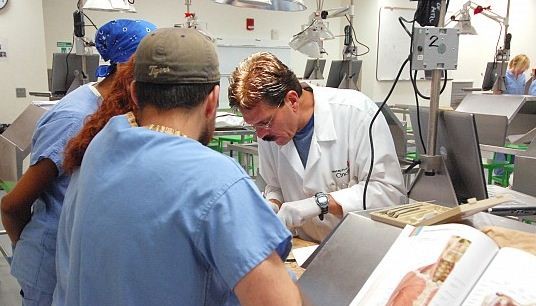
Bruce Giffin teaches technique prior to COVID-19 in the UC College of Medicine.
Giffin also makes available remotely a dissection video that focuses on each region of the body covered in the course.
“This way the students can get a good sense of the three-dimensional relationships of the anatomic structures with one another,” says Giffin. “This is a value-added aspect of actually doing the dissection on a cadaver and the dissection videos help to make up for that loss. I narrate the videos and try to give the students an understanding of how the dissection sequence is done along with the function of the anatomical structures and the clinical relevance where warranted.”
A gross anatomy digital image bank of cadavers is also available showing regions of the body that have previously been dissected. “So, for the face, I put together an image bank that has pictures of face dissections with the various structures the students should be able to identify labeled,” says Giffin. “This digital image bank is then the basis for the practical exams, which are also digital.”
Student response has been generally positive in light of changes due to COVID-19.
“Inherently, lab experiences require in-person use of the resources at the Medical Sciences Building,” says Scottie Emmert, a first-year medical student. “However, Dr. Giffin has recorded new lectures for all of the gross anatomy dissections and created detailed image banks with all of the anatomy we would have dissected.”
“One of the components of the course that I was most looking forward to, Content Integrations, had to be cancelled due to COVID-19,” says Emmert. “These were in-person sessions where Dr. Giffin used patient cases and other real-life scenarios to reinforce the lecture content we covered that week. Since we can no longer have content integrations, Dr. Giffin has generated banks of problem questions covering the anatomy and each week’s lecture material that allow us to apply the lecture content to clinical medicine. These have been enormously helpful and great resources.”
Using telehealth to sharpen patient encounter skills
During the first two years of medical school, students take a clinical skills course that involves encounters with simulated patients.
Once a week they work in their groups to do a full medical history, a physical exam and clinical reasoning to come up with a treatment plan and then communicate back to a patient. The cases created are aligned with other medical material in their other classes, says Dr. Dana Sall, assistant professor in the UC Department of Internal Medicine.
Sall and Matthew Kelleher, an assistant professor of internal medicine and pediatrics, are co-directors of the clinical skills courses for first- and second-year students. Sall and Kelleher also see patients at UC Health.
Students are working with simulated patients via Zoom. Normally, they would have these in-person experiences in clinical skills rooms in the College of Medicine’s Simulation Center. The scenario is designed to mimic an encounter in a physician’s office.
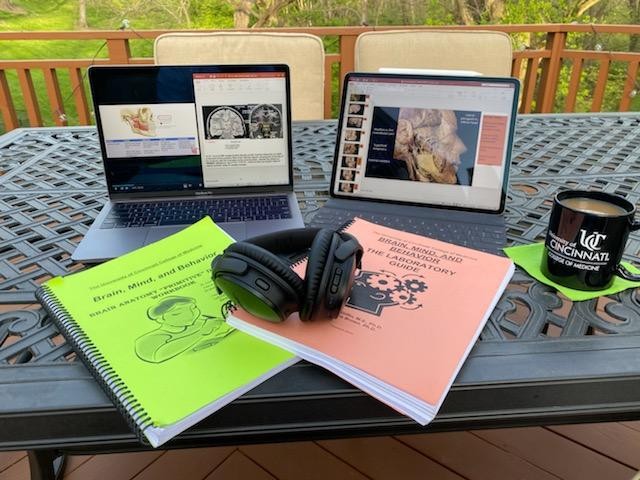
Distance learning looks similar to this for UC College of Medicine students and many others.
“Obviously, they can’t be at school and have this experience in the midst of COVID-19,” explains Sall. “Normally, they would get a chance to work in a group, take what they are learning in books and translate it to a real person. We try to recreate what that will be like given the limitations.”
Second-year medical students have completed the course, and they are wrapping up their exams. The exams were changed to a telehealth encounter and students interacted over Zoom with a standardized patient who needs an eVisit because they can’t come onsite because of COVID-19, explains Sall.
“You have to take a full history of the patient and then think about what was going on and explain the next steps back to the patient and what the diagnosis would be,” says Sall.
“They seemed to enjoy it and felt it was a nice distraction from what has been going on,” says Sall. "For the first-year med students they have four weeks left of the course, and we are creating telehealth encounters for them to do in their groups with a standardized patient. In a similar way, we will adapt the case to what is happening in the real world. We think the students will benefit from being able to interact with their usual peer group, and also because it may be a nice reminder of why they are studying so hard—to interact with and care for patients."
Nathan Lawera, a first-year medical student, seemed pretty excited about using Zoom to work with live standardized patients with his classmates. “This is pretty cool since we will be able to practice speaking to patients and what types of questions to ask while receiving live feedback,” he says.
Sall says staff at the College of Medicine Simulation Center have been essential in troubleshooting any technical problems with the telehealth simulated patient encounters. She and Kelleher considered other options as well.
“We looked into using a virtual reality program, but it didn’t quite align with our goals," says Sall. “For our first-year med students we tried pulling videos from prior encounters from last year and then Dr. Kelleher and I recorded over them and provided commentary.”
Zoom brought the patient interaction experience to life, says Sall. "We are excited to elict formal student feedback and see how we might incorporate telehealth experiences into the course even after operations return to normal."
Courtrooms go virtual too
A few months ago, students in Marjorie Corman Aaron’s two classes at the University of Cincinnati College of Law were preparing for their final projects: a simulated trial in her Trial Practice course and a session in her Client Counseling class.
Meanwhile, Aaron, a professor of practice and director of the Center for Practice at Cincinnati Law, was coordinating upcoming auditions for the college’s fall trial practice team, along with the team's officers.
Then COVID-19 arrived and everything abruptly changed.
Aaron’s classes are both highly experiential and incorporate simulations and class discussions. And auditions for the fall trial practice team involve 25-30 students delivering opening statements and closing arguments before a bevy of judges who grade them on delivery and content.
Yet when faced with the transition to remote learning due to the coronavirus pandemic, Aaron didn’t panic.
“I use video a fair amount in my classes in general. I’ve done some video calls before. I didn’t think it would be that hard,” she said confidently.
For help, Aaron turned to legal professionals across the nation who belong to group email lists she’s a member of that are geared toward faculty who teach trial advocacy and dispute resolution-related subjects.
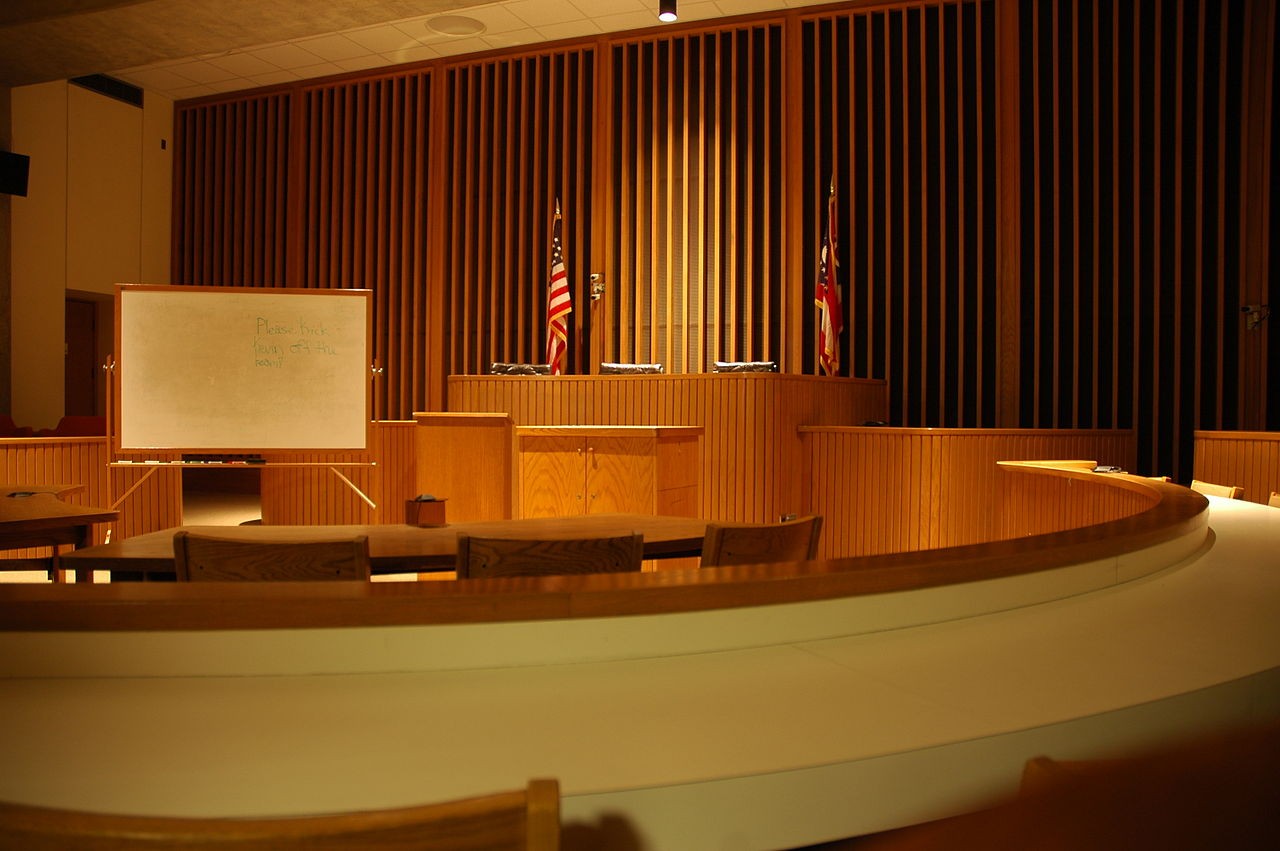
The UC College of Law's trial court room sits empty like all other teaching spaces on campus.
“A number of schools that had been doing this as part of online programming for a long time had a couple of virtual conferences in which they shared best practices with those of us who hadn’t done this before,” she said. “For most people who teach these experiential courses, it’s been working fine.”
For her Trial Practice course, Aaron used the video conferencing software Webex, which offers split video screens. As part of their final project, students — representing both the plaintiff and defense — logged on, along with Aaron, who served as judge and jury, and an actor playing the role of witness.
Students made preliminary motions, presented their opening statements and examined witnesses in the online space just as they would in one of UC College of Law’s two mock courtrooms, Aaron said.
In her Client Counseling course, students logged on to a video conferencing session with Aaron, who coached them throughout the exercise, and an actor playing the role of client. The goal? To update the client on a case status, requiring them to convey bad news about their chance of success. Students are called to explain complicated legal terms in plain language their clients can understand and propose a case resolution or settlement that doesn’t fall short of clients’ expectations.
“It’s so hard I can’t tell you,” Aaron said with a laugh about the grueling exercise. “My book on client counseling was prompted by the deep difficulty of this exercise.”
But even modifying the simulation for an online environment didn’t pose challenges, Aaron said. “It was no problem,” she said of the activity.
And when it came to auditioning students for the fall trial practice team, the switch to online technology even offered up some benefits.
Traditionally, Aaron and the trial team officers must coordinate a team of attorneys and instructors for the auditions, which are usually held on one evening. Students, who are challenged to deliver an opening statement they did not write and a closing argument they did write, rotate among different rooms where judges evaluate their construction and delivery.
This year, they made the whole process virtual. Twenty-eight students recorded themselves and submitted videos online using a classroom management software. Judges then had several days in which to review their submissions, after which they all met in conference via Webex to critique the auditions and choose the 15-member team.
“It was actually kind of great,” said Aaron. “We didn’t have to make sure every judge was available on Tuesday night. Even for students, they could upload their videos any time up until the deadline. The whole scheduling issue was just much, much easier.”
Aaron said that while the switch to online learning proved seamless for her courses, she’s looking forward to resuming classes in person.
“I want to be able to work with them all in the room," she said.
And, Aaron added, “I think students miss the class. I think we would all agree it was more fun when we were together.”
Further action is required to make this image accessible
One of the below criteria must be satisfied:
- Add image alt tag OR
- Mark image as decorative
The image will not display on the live site until the issue above is resolved.
Further action is required to make this image accessible
One of the below criteria must be satisfied:
- Add image alt tag OR
- Mark image as decorative
The image will not display on the live site until the issue above is resolved.
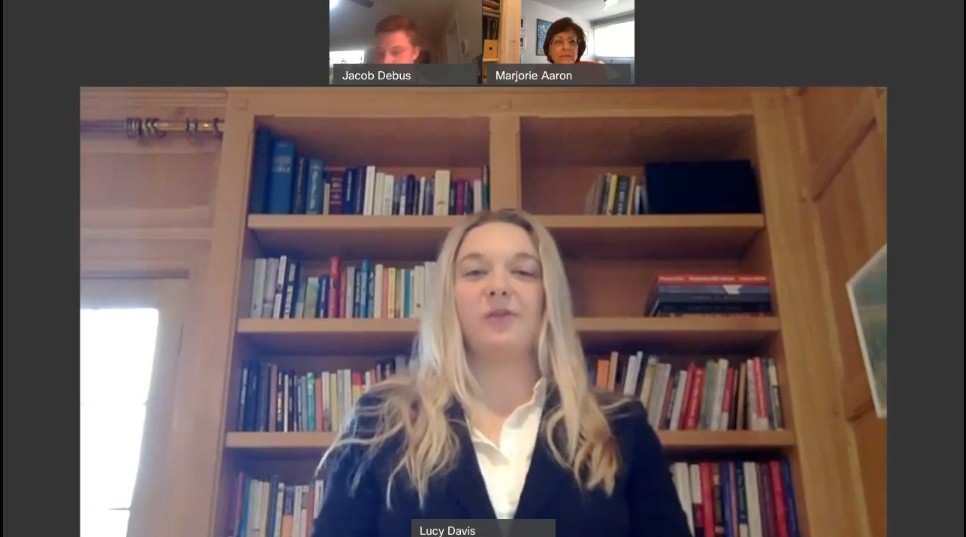
A screenshot of UC College of Law students Lucy Davis and Jacob Debus arguing a trial before Marjorie Corman Aaron using video conferencing software. The exercise is the students' final project in Aaron's Trial Practice course. Photo provided
Finding the silver lining
“A lot of art history is visually based with interactive discussion,” says Carla Cesare, UC Blue Ash assistant professor of art history. “So I was able to transition my art history course to online using Canvas fairly easily.”
But in Cesare’s design history course, students are also tasked with making 3D objects so she predicted quite a bit of that getting lost in an online format. To combat this hands-on limitation, Cesare takes objects that are in her home and creates a video analysis that she can show online.
For all her students who have to visit a museum to critique a work of art, the social distancing shutdown of famous museums around the world have serendipitously opened most of their collections to free virtual tours. Cesare sees this as a silver lining and secret blessing in many ways.
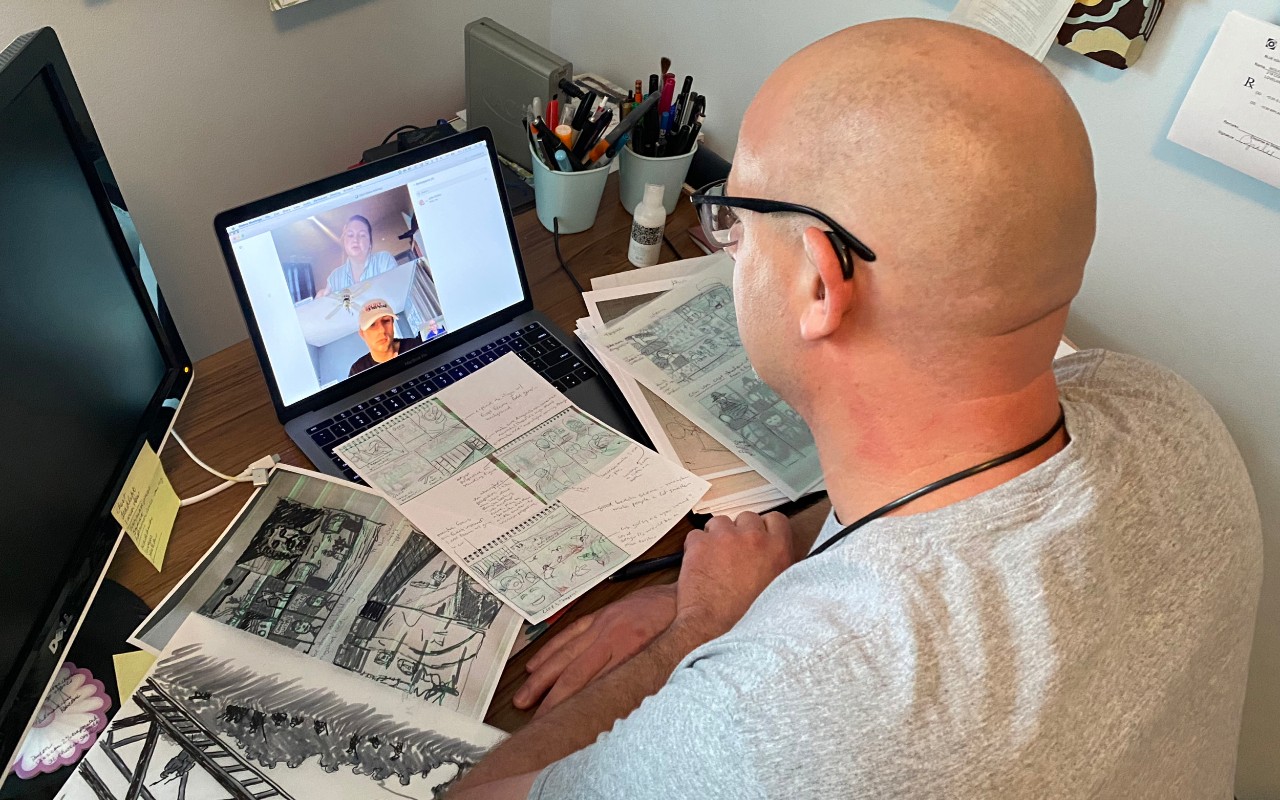
UC Blue Ash professor of art John Wolfer quickly renamed his course Emergency Virtual Teaching and Learning.
“They can now do a comparison of the work they saw in person at our local museum and contrast it to a similar work in a museum across the globe, one they may otherwise never have the chance to see up close.”
Through the new art history online transition, Cesare sees her students as much more competent to speak about art and better equipped to understand its role. Even if they don’t like a particular work they can now walk away understanding the value of it and go to museums around the world and see it in the same light, she says.
“So being able to visit a museum virtually and talk about it and really have something to exchange in a discussion is an opportunity they wouldn’t have been able to experience if not for the online transition.”
For someone unaccustomed to teaching online, UC Blue Ash professor of art John Wolfer quickly renamed his course Emergency Virtual Teaching and Learning. But with only a single drawing project remaining in the semester for students to complete, Wolter jumped right in and began using a combination of the Canvas and Webex programs to take his studio art classes online.
“It was a little scary at first,” says Wolfer, who usually teaches through a combination of lecture, demonstration, discussion and critique. “During regular in-person meetings students learn by watching each other work and ask questions as they organically come up, and I can shift back and forth when I see common issues arise.
“But the flip side to this sudden transition is that I have to be much more prepared for each class and each video conference.”
The demonstrations Wolfer usually presents during in-class time are now created outside class and he has since generated a large library of examples. Student discussions are now held on Canvas discussion boards with individual conferences scheduled with randomly paired students.
“They share screens with each other and provide feedback,” adds Wolfer. “I also print out their work in progress, use tracing paper to provide visual and written suggestions for improvement and email these directly to the students to provide an additional point of contact.”
With the project due next week, Wolfer is proud of how his students have responded. “I am fortunate to have a 100% participation rate,” he adds. “Students are saying they miss a lot of the real-time interaction, but they are finding a way to complete the work and stay connected with their peers.”
'Psychological first aid'
As an art therapist and psychologist who teaches both topics at UC Clermont and Uptown campuses, Meera Rastogi has had success adapting her discussion classes online. But for her art therapy class, Rastogi typically takes students to an internship site for field experience at the Hope Community Center in Clermont County, a mental health and substance use recovery center.
“That class has been totally based on working with members at this community center doing art with them on site for three hours a week,” says Rastogi. “So I’ve had to adapt that class differently. One thing we’ve been doing during the quarantine is to meet weekly online, completing something called psychological first aid, which teaches them how to help people in a natural disaster or crisis for non-helping professionals.”
While the course does not train them to be therapists, Rastogi says they do learn how to intervene in something like a COVID-19 crisis in order to be a support person.
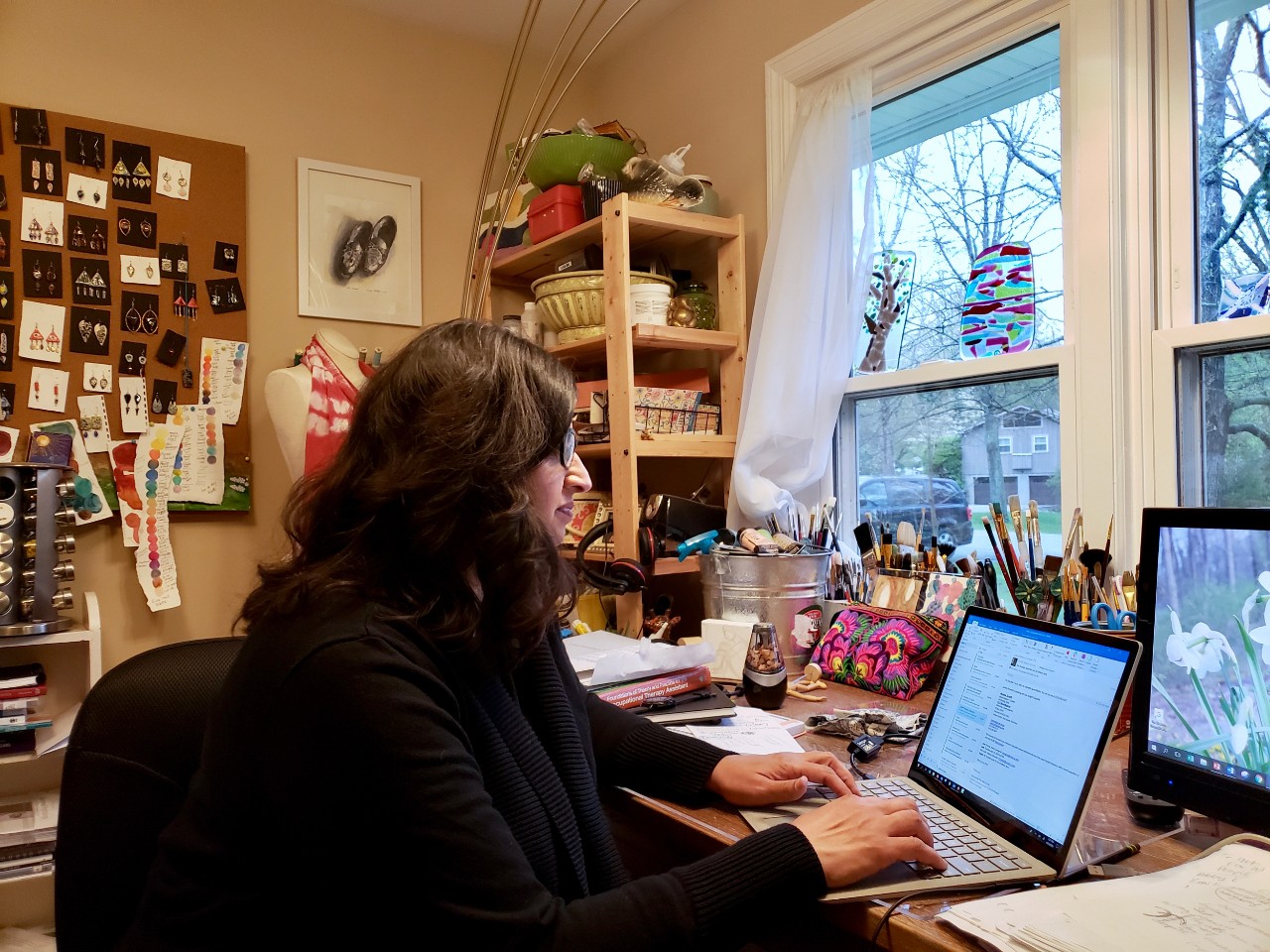
Meera Rastogi is an art therapist and psychologist who teaches both topics at UC’s Clermont and Uptown campuses.
Facing the challenge of taking her class out of the care center and into an online setting consists of students attending an online meeting using a real-time virtual program. They watch the videos, training materials and answer quizzes together prior to holding discussions about what they liked or didn’t like about different scenarios with good or bad interventions, she says.
“This summer I’ll be working with students on developing a virtual art program for the community center so we can continue to offer therapeutic art to them online and still serve the community,” adds Rastogi. “Having students help me facilitate this art program online is going to be something new for all of us but will ultimately open the prospects for more online teaching opportunities in the future.”
Featured image at top: UC Blue Ash professor of art John Wolfer teaches from his home office. The following members of the UC Media Relations + Content team contributed to this article: Bill Bangert, Jac Kern, Angela Koenig, Matt Koesters, Michael Miller, Rachel Richardson, Cedric Ricks and Melanie Schefft.
Impact Lives Here
The University of Cincinnati is leading public urban universities into a new era of innovation and impact. Our faculty, staff and students are saving lives, changing outcomes and bending the future in our city's direction. Next Lives Here.
Stay up on all UC's COVID-19 stories, read more #UCtheGood content, or take a UC virtual visit and begin picturing yourself at an institution that inspires incredible stories.
Tags
- Impact
- College-Conservatory of Music
- College of Pharmacy
- College of Medicine
- College of Arts and Sciences
- College of Allied Health Sciences
- Student Experience
- Academic Excellence
- College of Education, Criminal Justice, & Human Services
- COVID-19
- Faculty Staff
- Blue Ash College
- Clermont College
- College of Design, Architecture, Art, and Planning
- Graduate College
- College of Law
- #UCtheGood
- College of Nursing
- Lindner College of Business
- Next Lives Here
- College of Engineering and Applied Science
Related Stories
What might be going on if rest makes your back pain worse
July 8, 2025
The University of Cincinnati Gardner Neuroscience Institute's Joseph Cheng was featured in a SELF article discussing situations and strategies when rest appears to be making back pain worse.
Study traces evolutionary origins of important enzyme complex
July 8, 2025
New University of Cincinnati Cancer Center research published in the journal Nature Communications traced the evolutionary origins of the PRPS enzyme complex and learned more about how this complex functions and influences cellular biochemistry.
New Dungeons & Dragons ethics seminar takes flight
July 7, 2025
On a blisteringly hot summer day, laughter echoed through the cool, damp basement of the Avondale branch of the Cincinnati Public Library. Young teenagers huddled around a table littered with pencils and paper, rolling dice and bonding over a game of Dungeons & Dragons. University of Cincinnati undergraduate student Charitha Anamala sat behind a trifold card with a blazing red dragon on it, serving as the group’s Dungeon Master (DM) or campaign organizer. Within the fantasy setting she described, it was hard to tell the adventure was a lesson in ethics.
